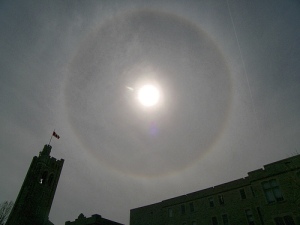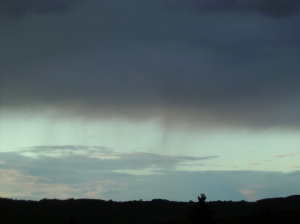I know it's not the done thing to diss the Romantic poets, but I'm not sure clouds are really lonely, are they? Let's anthropomorphise them for a moment, and consider the evidence in a logical and scientific manner.
Cumulus
Cumulus is a lumpy cloud. Its name comes from the Latin for "mass" or "heap". It's a good description; a lumpy heap of cloud.
It has clearly-defined edges, and looks like cotton wool. In my head, I can sleep in them because they look so very comfy. And when I'm in aeroplanes, I always think it would be nice to jump out and land in one. In fact, it is the type of cloud drawn expertly by children everywhere, and can be found moonlighting as Father Christmas's beard as and when required. A cloud such as this could not possibly be lonely.
Interesting fact about cumulus clouds: they form "streets" when they get together. And have street parties because they are harbingers of good weather; they don't generally grow tall, and so do not participate in precipitation.
Stratocumulus
Stratocumulus is a "flattened lump or heap". So, basically, it's a cumulus cloud with a hangover. It doesn't get high, forming in the lowest two kilometres of the atmosphere and, like it's more portly brethren, is not associated with precipitation.
I suppose an argument could be made for this cloud being lonely, but I would take issue with that. It has formed from a squishy mass of cumulus clouds, which is pretty neighbourly, and chose its own hungover state. It's usually found in the company of others, which makes it fairly sociable.
Arguably, this cloud is not lonely either. Also, it indicates high pressure and stable winter weather. So it is a pleasant fellow.
Cirrostratus
So named from the Latin cirrus, "wisp" or "curl", and stratus, "layer". A wispy layer of cloud. They spend their time high up in the atmosphere (between five and ten kilometres) as a veritable veil of ice crystals.
They often produce a halo effect (see photo) and indicate moist air and an approaching warm front. Cirrostratus and altostratus form from each other. Such close relationships indicate that cirrostratus are unlikely to be lonely clouds. Quite the opposite, in fact.
Cirrus
These wisps are the aloof clouds of the cloud world. They form in the highest and coldest regions of the trophosphere, are composed of ice crystals, do not bring rain, and they spawned Will 'o' the Wisp, Kenneth Williams' alter ego and entertainer of children of the 80s.
There is a variety of different cirrus clouds - cirrostratus, described above, is just one type. Others include cirrus intortus, tools of the Spanish Inquisition. Nobody expects the Spanish Inquisition to use clouds as instruments of torture. Cirrus castellanus is another type of cirrus cloud, used to build castles in the sky; and cirrus vertebratus has no backbone.
Cirrus clouds can be artificial too; contrails from aeroplanes are a type of cirrus cloud. You can judge wind direction up there by looking at how contrails are scattered. And if they persist, you know the relative humidity is quite high. If they disappear quickly, the air up there is very dry. So they're useful things too.
But they all join with each other, and with other cloud types, and are most definitely not lonely.
Nimbostratus
These are low-lying clouds that bring rain. They are named from the Latin "nimbus", meaning rain, and "stratus", meaning spread-out. They are big, with flat bases, and are often to be found engulfing the top of a hill. Of course, from the hill's point of view this stratus cloud would be fog. They are the bullies of the cloud world, being big grey brooding miseries, and are the friends of the hills.
They produce dull and gloomy wet days, with the cloud base often touching the ground. The word "fug" describes them nicely.
I suppose that these clouds could be described as lonely. But they don't wander, so my original point stands.
Anyway.
As part of Block 2: Air and Earth, we are studying weather systems. This is, sadly, not as interesting as I thought it might be. I think the extreme weather comes in later in the course. For now, the only thing that has held my interest is the clouds.
I love clouds. They bring depth and mood to the sky, and can often be found making interesting shapes - like pigs, and teapots, and - on the odd occasion - snakes and slippers.
They can also give you a clue as to what the weather may do next, if you know what you're looking for. So this post was really for my benefit; to make sure I've got a vague idea of what clouds look like, and what they herald weather-wise.
I still think cumulus clouds would make a grand bed though. The laws of physics and common senses be damned.





Comments
New comment
Hi Vicki..I love clouds too..and first named(catalogued) by an Englihman..Luke Howard. be well Anthony